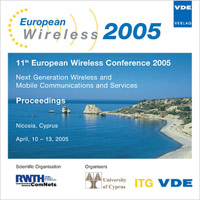Combining Multi-User Diversity with Eigenbeamforming in Correlated Channels
Konferenz: European Wireless 2005 - 11th European Wireless Conference 2005 - Next Generation wireless and Mobile Communications and Services
10.04.2006 - 13.04.2005 in Nicosia, Cyprus
Tagungsband: European Wireless 2005
Seiten: 7Sprache: EnglischTyp: PDF
Persönliche VDE-Mitglieder erhalten auf diesen Artikel 10% Rabatt
Autoren:
Castañeda, Mario; Joham, Michael; Ivrlac, Michel (Institute for Circuit Theory and Signal Processing, Munich University of Technology, Arcisstrasse 21, 80333 Munich, Germany)
Inhalt:
In a time varying point-to-multi-point link such as the downlink of a network with a base station and several users, there exists an inherent form of diversity called multi-user diversity. This diversity is harnessed by the use of a proper scheduler such as the proportional fair scheduler. Among other factors, the multi-user diversity gain is determined by the dynamic range of the channel fluctuations. For several scenarios including correlated fading channels, this range can be increased by deploying multiple antennas at the transmitter and using opportunistic beamforming. However, point-to-point link transmitting techniques such as eigenbeamforming exist that have proven to be useful in correlated channels. We present the concept of exploiting multi-user diversity in correlated channels with eigenbeamforming. We show how combining eigenbeamforming with the proportional fair scheduler results in a larger multi-user diversity gain than the one achieved through opportunistic beamforming.


